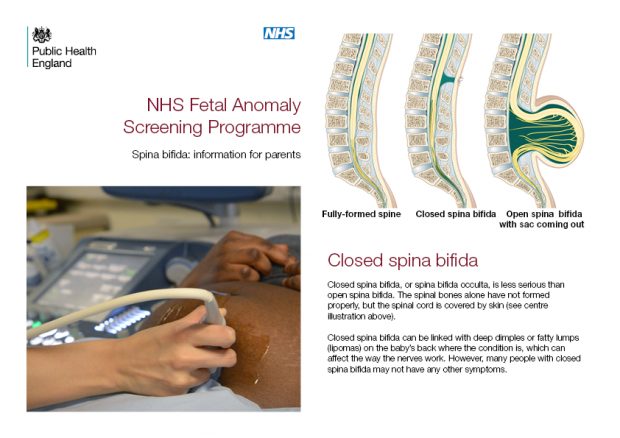In our blog article on 30 January we told you about our work to update the parent information leaflets covering the 11 conditions we screen for at the fetal anomaly screening programme mid-pregnancy scan.
This scan (also called the 20 week scan) screens for conditions that:
- benefit from treatment before or after birth
- need treatment in a specialist setting after birth to optimise health outcomes, or
- mean the baby may sadly die shortly after birth
We have been working with clinical experts and patient groups to update the leaflets, incorporating the latest evidence and following plain English principles to make sure they are clear, concise and user friendly.
Today, we have published updated parent information leaflets covering:

Anencephaly
Anencephaly is a condition in which the baby’s brain and spinal cord (the fetal nervous system) do not develop properly.
This is a very serious condition and large parts of the skull and brain are missing. Unfortunately, there is no treatment for anencephaly and most babies (up to 3 out of 4) with the condition are stillborn. Babies who survive throughout the pregnancy die shortly after birth. On rare occasions, babies may live for a few days.
We do not fully understand why anencephaly happens. It is found in about 5 in every 10,000 pregnancies (0.05%).
Spina bifida
A structure called the neural tube should form in the developing baby by day 28 of pregnancy. This eventually becomes the baby’s nervous system.
Spina bifida is a condition in which part of the baby’s neural tube does not develop or close properly. This leads to the spinal cord or vertebrae not developing as they should.
Spina bifida varies in seriousness and outlook, and we do not fully understand why it happens. It is found in about 6 out of every 10,000 babies (0.06%).
Developing the new leaflets
We started by reviewing the literature and published evidence on the conditions and worked closely with experts from fetal medicine, paediatric neurosurgery and neonatal care as well as charities, support groups and parents.
We are particularly grateful to Professor Jan Deprest, a consultant in fetal medicine at University College London and the director of the fetal surgery programme in UZ Hospital, Belgium, for his input, and for kindly letting us use the illustrations in the spina bifida leaflet.
These leaflets should support, but not replace, discussions with health professionals. We recognise that only parents know what is the best decision for them and their family and that healthcare professionals will support them whatever their decision.
The leaflets also signpost parents to relevant support groups and information on NHS.UK.
PHE Screening blogs
PHE Screening blogs provide up to date news from all NHS screening programmes. You can register to receive updates direct to your inbox, so there’s no need to keep checking for new blogs. If you have any questions about this blog article, or about population screening in England, please contact the PHE screening helpdesk.